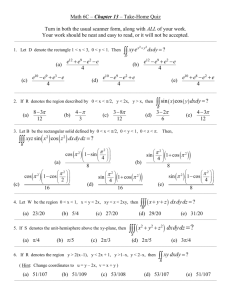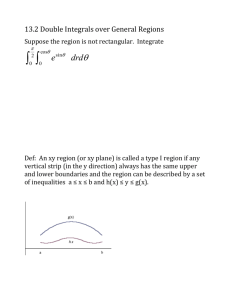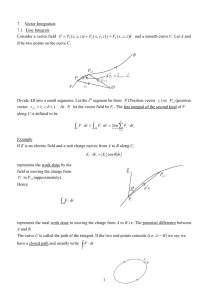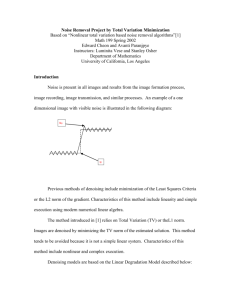Quiz 14 Solutions - Bakersfield College
advertisement
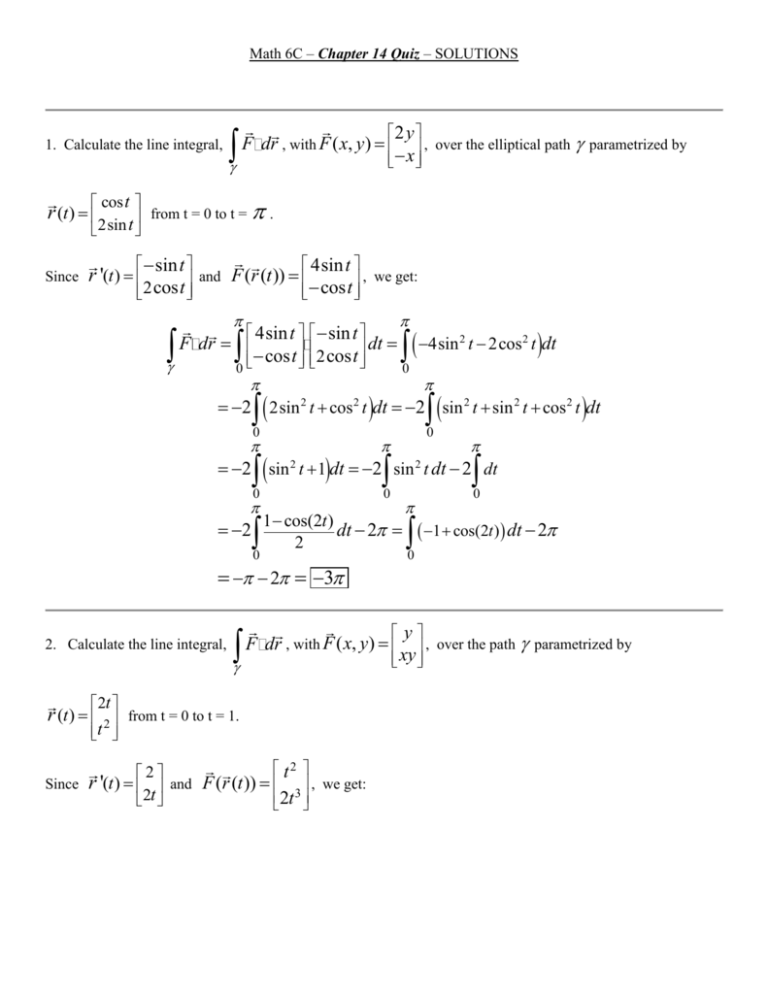
Math 6C – Chapter 14 Quiz – SOLUTIONS 1. Calculate the line integral, 2 y , over the elliptical path x F dr , with F ( x, y) parametrized by cos t from t = 0 to t = . 2sin t r (t ) Since sin t and 2 cos t r '(t ) 4sin t , we get: cos t F (r (t )) 4sin t cos t 0 F dr sin t 2 2 dt 4sin t 2cos t 2 cos t 0 dt 2 2sin t cos t dt 2 sin 2 t sin 2 t cos 2 t dt 0 2 0 2 2 sin t 1dt 2 sin t dt 2 dt 0 2 0 2 0 1 cos(2t ) 2 dt 2 1 cos(2t ) dt 2 2 0 0 2 3 2. Calculate the line integral, 2t from t = 0 to t = 1. 2 t r (t ) 2 Since r '(t ) and 2t y , over the path parametrized by xy F dr , with F ( x, y) t2 F (r (t )) 3 , we get: 2t 1 F 1 2 2 4 dr dt 2t 4t 2t 0 1 t3 t5 2 4 22 2 4 5 3 5 15 3 0 t2 3 2t 0 3. Calculate 1 1 dt 2 t dt 4 t dt 2 4 0 0 F dr with F (x, y) g(x, y) , where g(x, y) 2x xy , over the path 2 t 2 parametrized by r (t ) from t = 0 to t = 1. t 3 Since F ( x, y) g ( x, y) , we have: F dr g (r (1)) g (r (0)) g (1,1) g (0,0) 1 0 1 4. Suppose that 2 xy with 2 x g ( x, y) g (0,0) 0 . Then g ( x, y) ? 2 xy g x 2 x g y g g x 2xy g 2xy dx x2 y c( y) g y x2 x2 c '( y) c( y) C Then 5. Calculate g ( x, y) x2 y c , so g(0,0) 0 c 0 , and so g ( x, y) x2 y . 2 xy , over the path 2 x F dr with F ( x, y) g ( x, y) 1,1 along the circle from the point x2 y 2 2 . F dr g (r (1)) g (r (0)) g 1 0 1 2, 0 g (1,1) 2, 0 to 6. Suppose that y2 2x with 2 xy g ( x, y) g (0,0) 0 . Then g ( x, y) ? y2 2x g x 2 xy g y g g x y 2 2x g y 2 2x dx xy 2 x2 c( y) g y 2xy 2xy c '( y) c( y) C Then 7. Calculate g ( x, y) xy 2 x2 c , so g(0,0) 0 c 0 , and so g ( x, y) xy 2 x2 . 2 2x , over the path 2 xy y F dr with F ( x, y) g ( x, y) from the point ( 1, 2 ) to from the point ( 0, 1 ) to ( 3, 1 ) along the line segment connecting these two points. F dr g 3,1 g (1,2) 6 3 9 8. Calculate ( y2 2x , over the path 2 xy F dr with F ( x, y) g ( x, y) , –1 ) along the curve y = cos x. F dr g , 1 g(0,1) xy M ( x, y) 9. If F ( x, y) x and N ( x, y) y (1,3), then 2 0 2 is the boundary of the square with vertices (1,1), (3,1), (3,3), Mdx Ndy ? By Green’s theorem we have that Mdx Ndy N dx R M dxdy dy 3 3 1 1 x dxdy x dxdy y y 1 1 R Mdx Ndy 3 3 1 1 1 dxdy y 3 2ln y x 10. Suppose N M 5 x y 3 1 1 1 x dxdy 3 2 1 3 3 3 3 3 1 1 1 dy dx dy x dx y 1 2ln3 8 1 and region R has an area of 2 and has boundary that is a simple closed curve. Mdx Ndy ? Then By Green’s theorem, Mdx Ndy 11. Suppose N dx R F is a gradient field, and so M dxdy dy R 5dxdy 5R dxdy 5 2 10 . F g , where g x, y, z x2 cos y sin( z y 2 ) . If r t 5 cos t, 3 sin t, 2 cos t 12. If is the circle with 0 t 2 , then is the ellipse parametrized by F dr = F dr 0 over any closed path such as . x2 y 2 9 , then y dx x dy = ? 2 2 y2 M about the given circle of radius 3. This integral is the circulation of F ( x, y) x 2 N By Green’s theorem, N M Mdx Ndy 2 x 2 y dxdy 2 x y dxdy . dxdy dx dy R R R Changing to poplar coordinates, we get 2 3 0 2 3 r cos r sin r drd 0 2 13. If F ( x, y) interior of 0 3 0 cos d r dr r cos drd 2 0 0 2 0 2 2 3 0 0 r 2 sin drd 3 0 sin d r 2 dr 0 M 2 and is the unit circle centered at the origin. If R is the circular x2 y 2 N N M , then = ? [ Hint: this time it’s easier to compute the line integral! ] x y x2 y 2 dA R By Green’s theorem, N dx R M dxdy Mdx Ndy . dy We will use the unit-circle parametrization, cos t , from t = 0 to t = sin t r (t ) 2 1 and F (r (t )) , for all t, we get 1 Mdx Ndy sin t cos t dt 0 . 0 y2 14. Compute the flux of the field F ( x, y, z ) x 2 through the portion of the surface z above (or below) the rectangle in the xy-plane with corners at (0,0), (3,0), (3,2), (0,2). The flux is given by the integral described by sin t cos t 2 . Since r '(t ) S F nˆ d . Let z y 2 x2 G( x, y, z) x2 y 2 z , so the S is the surface G( x, y, z) 0 . Then, d G G kˆ dxdy F nˆ F ( x, y, y 2 x 2 ) 2 x, 2 y,1 1 dxdy 4 x2 4 y 2 1 dxdy , and 2x 1 2 y 4 x2 4 y 2 1 1 y2 1 x2 4 x2 4 y 2 1 2 2 y x 2x 2 y 1 that is 2 xy 2 2 x2 y y 2 x2 . F nˆ 4 x2 4 y 2 1 Thus, 2 3 S F nˆ d 0 0 2 3 2 xy 2 2 x2 y y 2 x2 4 x2 4 y 2 1 dxdy 4 x2 4 y 2 1 0 2 xy 2 2 x 2 y y 2 x 2 dxdy 2 3 2 2 3 0 2 3 2 3 0 0 xy dxdy 20 0 x ydxdy 0 0 y dxdy 0 0 x dxdy 2 2 0 2 3 2 y dy 2 2 2 3 2 2 3 2 3 0 xdx 20 ydy0 x dx 0 y dy 0 dx 0 dy 0 x dx 2 y3 2 3 2 2 0 3 2 0 0 y2 x2 2 2 2 2 2 3 2 0 0 y3 x3 3 3 x3 3 2 3 3 0 23 32 22 33 23 33 2 3 2 22 3 2 2 3 3 3 yz 15. Compute the divergence of the vector field F ( x, y ) xz . xy x yz F ( x, y) xz 0 0 0 y xy z 0 yz 16. Compute the outward flux of F ( x, y ) xz through the surface x2 2 y 2 3z 2 xy Since the divergence of this field is identically zero, the divergence theorem gives us: 0dV 0 . F nˆ d FdV V S V yz 17. Compute the curl of the vector field F ( x, y ) xz . xy 1 . x yz F ( x, y) xz y xy z y z x , xy z xz x , xy y yz yz xz x x, y y, z z 2 x, 0, 2 z yz 18. Compute the circulation of F ( x, y ) xz around the square curve xy (2,2,1), (0,2,1). with corners (0,0,1), (2,0,1), F dr ? By Stoke’s theorem, F dr S F nˆ d , S being the interior of the given square. 0 parallel to the xy-plane, it follows that n̂ 0 , and that d 1 the results from problem #17, the above integral becomes Since S is dxdy . Since z=1 on this square, and using S F nˆ d S (2x,0, 2 1) (0,0,1) d 2 2 2 dxdy 8 0 0 19. Suppose that xyz F g with g ( x, y, z) . Then F ? 1 x6 y8 z10 The curl of any gradient field is zero: F 0 20. Compute the circulation of the field F ( x, y) featured in #19, around the square curve (0,0,1), (2,0,1), (2,2,3), (0,2,3). F dr ? The circulation around any closed curve is zero, for any gradient field: F dr 0 with corners
